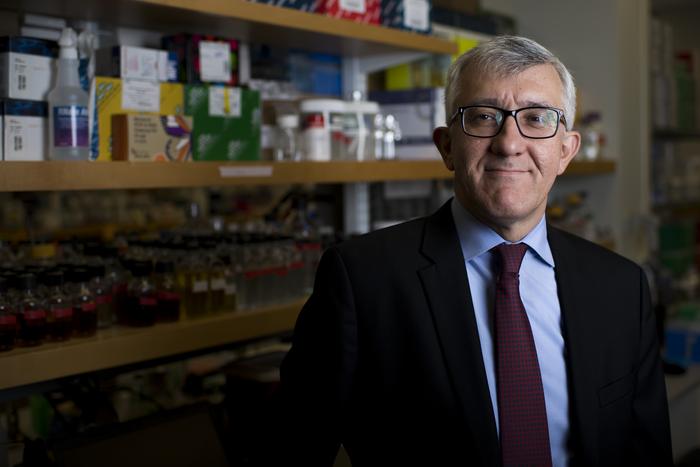Cambridge, Mass., Jan. 16, 2024 – A team of researchers from the ADA Forsyth Institute and University of North Carolina (UNC), Chapel Hill used single-cell transcriptomic analysis to successfully map dental pulp stem cells (DPSC) and periodontal ligament stem cells (PDLSC) and found remarkable differences between them. The study, which appeared in the Journal of Dental Research, provides the most detailed analysis of these stem cells to date, identifying the entire genome of the stem cells and their potential differentiation trajectories.

Credit: ADA Forsyth Institute
Cambridge, Mass., Jan. 16, 2024 – A team of researchers from the ADA Forsyth Institute and University of North Carolina (UNC), Chapel Hill used single-cell transcriptomic analysis to successfully map dental pulp stem cells (DPSC) and periodontal ligament stem cells (PDLSC) and found remarkable differences between them. The study, which appeared in the Journal of Dental Research, provides the most detailed analysis of these stem cells to date, identifying the entire genome of the stem cells and their potential differentiation trajectories.
“Dental pulp and periodontal ligament stem cells both have the potential to develop into any type of cell in the body,” explained ADA Forsyth Scientist, Alpdogan Kantarci, DDS, MSc, PhD who led the study with UNC biostatistician, Di Wu, PhD. “We wanted to discover how they were different and whether there were differences in their capacity to differentiate into other cell types.”
The team discovered that both types of stem cells have seven different gene clusters, with different categories of genes reflecting different stages in the process of differentiation. Four of those gene clusters were similar when comparing the two types of stem cells. Three of the clusters were uniquely different. While PDLSC’s were more like fibroblasts (cells that can become connective tissue) because of an increased proportion of certain clusters, DPSCs had higher differentiation potential and converted more easily into bone cells.
“This new information on the specific genetic composition and mechanisms of differentiation in dental pulp and periodontal ligament stem cells will generate a new era of work in regenerative medicine” said Dr. Kantarci. “We could potentially select a stem cell based on its distinct properties to create targeted regenerative dental tissue repair and other regenerative therapies.”
ADA Forsyth scientists obtained the stem cells from extracted teeth without culturing them (unlike other studies of these stem cells) and sent them unfrozen to UNC for single-cell transcriptomic analysis. Meanwhile, they also took the same cells and differentiated them into known cell types such as fibroblasts (cells that can become connective tissue) and osteoblasts (bone cells). The team then used advanced bioinformatics to compare and document the capacity of the two populations of stem cells to differentiate into osteoblasts or fibroblasts. The results of the bulk RNA sequencing validated the findings of the single-cell transcriptomics.
“Prior to this study, people believed that stem cells were either very similar to each other, or very different from one another,” said Dr. Kantarci. “Now we have enough information to see the huge potential for using specific features of these stem cells to create more effective and targeted regenerative therapies.”
Additional collaborators on the project included T. Van Dyke, H. Hasturk, and Y.C. Wu of ADA Forsyth; Y. Yang, T. Alvarez, M.Z. Miao and G. Li of UNC Chapel Hill; and, J. Lou of University of Washington, Seattle.
Funding:
This work was funded by NIH/NIA (AG062496) and NIH/NIDCR (DE025020) grants, and the University of North Carolina Computation Medicine Program Award 2020. T. Alves holds a J. William Fulbright Scholarship (CAPES—finance code 001). M.Z. Miao is supported by the Intramural Research Program of the National Institutes of Health, National Institute of Dental and Craniofacial Research ZIA DE000719 and ZIE DE000727.
Paper cited:
“Single-Cell Transcriptomic Analysis of Dental Pulp and Periodontal Ligament Stem Cells,” Journal of Dental Research. DOI: 10.1177/00220345231205283
###
About the ADA Forsyth Institute
The ADA Forsyth Institute was founded in 1910 as the Forsyth Dental Infirmary for Children (later, the Forsyth Institute), to provide dental care to the disadvantaged children of Boston. While continuing to serve children in need, yet recognizing the ultimate goal is to prevent dental disease, the Institute in 1915 began to focus on scientific research and is today the world’s leader in oral health research. In October of 2023, the Institute joined with the American Dental Association to form the ADA Forsyth Institute, a 501(c)(3) entity dedicated to improving people’s oral and overall health and powering the profession of dentistry through cutting-edge basic research, creative translational science, innovative clinical technologies, and global public health outreach. Consistent with the Institute’s founding mission, the ADA ForsythKids mobile dental program continues to serve children in need.
About the American Dental Association
The not-for-profit ADA is the nation’s largest dental association, representing 159,000 dentist members. The premier source of oral health information, the ADA has advocated for the public’s health and promoted the art and science of dentistry since 1859. The ADA’s state-of-the-art research facilities develop and test dental products and materials that have advanced the practice of dentistry and made the patient experience more positive. The ADA Seal of Acceptance long has been a valuable and respected guide to consumer dental care products. The Journal of the American Dental Association (JADA), published monthly, is the ADA’s flagship publication and the best-read scientific journal in dentistry. For more information about the ADA, visit ADA.org. For more information on oral health, including prevention, care and treatment of dental disease, visit the ADA’s consumer website MouthHealthy.org.
Journal
Journal of Dental Research
DOI
10.1177/00220345231205283
Method of Research
Experimental study
Subject of Research
Cells
Article Title
Single-Cell Transcriptomic Analysis of Dental Pulp and Periodontal Ligament Stem Cells
Article Publication Date
20-Nov-2023
COI Statement
The authors declared no potential conflicts of interest with respect to the research, authorship, and/or publication of this article.




